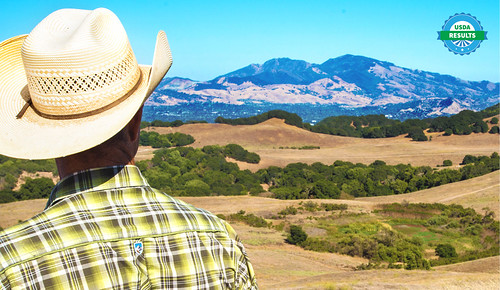
USDA is bringing tools and solutions to farmers, foresters and ranchers so they have help confronting climate change while working to produce a global food supply adequate to feed the 9 billion people estimated by 2040 while still protecting the earth’s natural resources.
Today, USDA is launching the fifth chapter of USDA Results, telling the story of how USDA has been working since 2009 with partners across the country and around the world to curb the effects of climate change for a healthier tomorrow. Throughout May, we will be announcing new projects and highlight the progress we’ve made under Secretary Vilsack’s leadership, which has made this issue one of his top priorities. Here in the Climate Change Program Office and in Agencies across the Department, we have been busy.
USDA established a network of Climate Hubs in 2014 to deliver practical information based on science along with tools, strategies, and technical support for adapting to climate change to farmers, ranchers and forest land owners. America’s farmers and ranchers are seeing increasingly severe weather pose a threat to their operations, production and their bottom line on an annual basis. The network of 10 USDA Climate Hubs and Sub Hubs are already helping provide voluntary, practical smart climate solutions so operations can stay profitable. We’ll be highlighting the work each Hub is doing and featuring them on the USDA Blog this month, so check back.
Secretary Vilsack launched actions to combat climate change. Last year, he announced USDA's Building Blocks for Climate Smart Agriculture & Forestry last year to provide incentives and technical assistance to farmers, ranchers, and forest land owners. Building on USDA’s track record of "cooperative conservation," the comprehensive set of voluntary programs and initiatives are key to reducing net emissions and enhancing carbon sequestration by over 120 million metric tons of CO2 equivalent annually by 2025 - the equivalent of taking 25 million cars off the road.
Our nation’s farmers, ranchers, and forest landowners have proven they can achieve extraordinary gains in productivity while acting as good stewards of our natural resources. With the recent signing of the Paris Agreement we have in place a long-term and durable framework to reduce global greenhouse gas emissions and build resiliency for the future. At home and abroad, USDA and its partners will continue to demonstrate that climate-smart strategies can build resilience, reduce global greenhouse gas emissions, and increase carbon storage in our soils and forests while boosting productivity and improving global food security. Important partnerships including the Global Alliance on Climate Smart Agriculture and the Global Research Alliance on Agricultural Greenhouse Gases are spreading the news of how climate-smart strategies can reduce global greenhouse gas emissions and increase carbon storage while increasing food production to feed a growing world.
In the next decades to come, Americans in all walks of life will face the growing challenges of a changing climate. USDA is working so our nation is in front of these challenges at home and provides global leadership in the fight against climate change and to ensure the resilience of our farms and forests.



